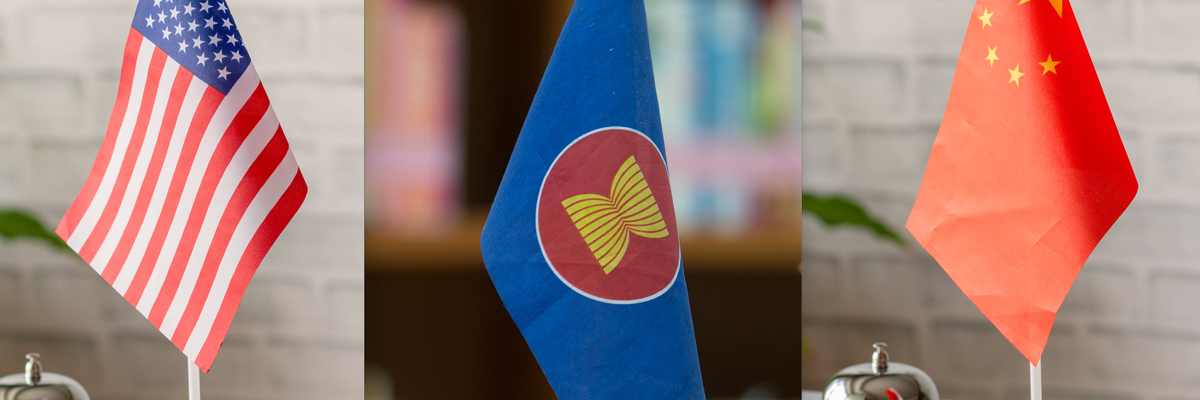As Southeast Asia’s leaders met with each other and other major powers at the annual ASEAN and East Asia summits this week, much media attention was focused on the Myanmar crisis and the grouping’s decision to bar the Myanmarese junta from attending the event. But unfavorable trends in geopolitics centered on Asia were likely even more on the leaders’ minds.
We are at an inflection point in Asia at which regional security is endangered like it hasn’t been in decades. The militarization of the Quad since its rebirth in 2017, the formation of AUKUS involving (among other things) the building of offensive submarine capability and enhancing U.S. troop presence in Australia, and a series of gaffes (that may not be gaffes) by President Biden on Taiwan are widening fault lines in Asia. Recent hints of an expansion of AUKUS and raising its ambition are even more problematic. This process is being aided in significant measure by China’s stepped up intrusions in disputed maritime zones and the rapid expansion of Chinese naval capabilities.
Extra-regional powers beyond the United States have not been shy of showing up in unhelpful ways either. These include the assertive entry of the United Kingdom through AUKUS and its naval sails through the Taiwan Strait, the robust armed presence of France, and recent joint Chinese and Russian naval activity circling Japan. If current trends of me-too militarization and obstreperous chest-thumping continue, there can be no good outcome for the region and the world.
Southeast Asia has until now mostly managed these pressures by artfully hedging against the United States and China. Hedging has meant active engagement rather than neutrality, and a deepening of ties with both. Preferential tilts by individual ASEAN states are allowed, but entering into new military alliances, formal or informal, has been generally avoided in the post-Cold War era. Southeast Asian hedging also involves proactively putting an economic foot forward to give a stake to all powers, great and not-so-great, so that all may benefit from its success. The ASEAN-led Regional Comprehensive Economic Partnership is the most visible example of this approach.
The question is whether a policy of security hedging is sustainable as the U.S.-China dynamic enters fraught terrain. The United States says that it is not asking Southeast Asian states “to choose between the U.S. and China.” But AUKUS is just the latest sign that Asia’s tectonic plates are shifting in ways that will require Southeast Asian states to adopt a proactive policy precisely to prevent such choices being thrust on them in the future.
From one standpoint, ASEAN is an ideal forum for fashioning a retooled strategy. It has an enviable track record of integration of a vastly diverse region with a history of ethnic conflict and, in recent decades, a story of stellar economic rise. It has been friend to most and foe to none. Its low-key approach of non-intervention and decision-making through consultation and consensus can be seen as, well, Restraint, Asian style.
But ASEAN’s time-tested formulas may need to be adapted to what’s coming. Non-intervention is hard to sustain in its absolute form while Myanmar burns and state failure within the ASEAN family looks like a distinct possibility with all its spillover effects. Externally, ASEAN seems helpless to curb the emerging Great Power Competition that could, in a dystopian scenario, turn the region into a theater for coercive sanctions, periodic military crises, and even proxy wars. Hedging works up to a point, but if zero-sum framing becomes the norm in Washington and Beijing, then Southeast Asian omni-directionality will be seen by both sides as more provocation than bridge-building.
ASEAN may need to shed its historic reticence and avoidance of difficult topics and adopt a denial policy of its own — albeit, a diplomatic, rather than military version. Denial, ASEAN-style, would mean at its core rejecting and opposing the emerging bipolarity in Asia organized along so-called “coalitions,” which are really contemporary, informal forms of military blocs of the old.
What does this mean in terms of specifics? ASEAN states should consider collectively and clearly opposing AUKUS and especially its dangerous potential for expansion. Indonesia and Malaysia have already come out in this vein, individually, and most significantly, also jointly. ASEAN states might also wish to support the Quad’s evolution into a space for non-military, positive-sum activities such as health and climate action, while discouraging its militarization, symbolized by China-oriented exercises such as Malabar, featuring anti-submarine warfare.
At the same time, Chinese intrusions and pressure tactics in the maritime domain could be highlighted more explicitly, and no ground yielded on Chinese demands to impose a veto on security relationships with extra-regional powers in the Code of Conduct negotiations over the South China Sea disputes. Such a veto is opposed by most ASEAN states due to their concerns about Chinese hegemony. But these states would also not like to give each other similar veto power, according to Singapore-based academic Chong Ja Ian. Russian-Chinese bloc formation on Asian matters, though currently at an embryonic stage, should also be viewed unfavorably.
These moves carry risks of displeasing both great powers simultaneously — and Southeast Asia suffering short-term consequences as a result. But it is better to make a serious attempt to exercise restraint on the great powers before darker scenarios become a fait accompli. Admittedly, getting a consensus on these positions within ASEAN, with all its diversity of views, is highly challenging. But there’s nothing to stop a subset of Southeast Asian states stepping up. Perhaps this could encourage the rest to follow in due course. Indonesia and Malaysia may be well-suited to lead such an effort. If they are ambitious, they could also engage South Asia in evolving such a new consensus.
The United States, for its part, has already acted provocatively and unwisely in initiating AUKUS, is taking huge risks on the Taiwan issue by eroding the time-tested One-China policy, and has needlessly militarized the Quad. But it can stop making things even worse. Washington should be true to its word and stay away from using strong-arm tactics, overt or covert, to push ASEAN states to pick sides or decouple substantially from China. Such tactics risk generating regional blowback. The United States appears to be avoiding this course at the moment, but coercive options will be increasingly tempting as the rivalry with China heats up.
Instead, a turn toward greater incentives to strengthen the U.S. position and influence in the region would be much more productive in the longer run. The United States has been a robust investor in Southeast Asia, but China is by far ASEAN’s largest trade partner. Observers have long pointed out that the United States lacks an economic game in Southeast Asia — a major shortcoming. President Biden’s announcement of support to the tune of $100 million at the ASEAN summit for health, environmental, education and other efforts in Southeast Asia, was a constructive step. But a nation that can muster trillions of dollars at will to deal with a pandemic and a financial crisis, can do better in Southeast Asia. Climate change ought to be central to U.S. efforts in the region, and the Quad’s stated intentions to focus on this arena must be translated into action. If the United States plays its cards wisely, consistent with a grand strategy of Restraint, it can still retain much of its influence and goodwill in Southeast Asia.
















